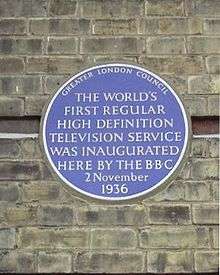Alexandra Palace
Alexandra Palace is a Grade II listed[2] entertainment and sports venue in London, situated between Wood Green and Muswell Hill in the London Borough of Haringey. It is built on the site of Tottenham Wood and the later Tottenham Wood Farm.[3] Originally built by John Johnson and Alfred Meeson, it opened in 1873 but following a fire two weeks after its opening, was rebuilt by Johnson. Intended as "The People's Palace" and referred to as "Ally Pally", its purpose was to serve as a public centre of recreation, education and entertainment; North London's counterpart to the Crystal Palace in South London.[4]
.jpg) | |
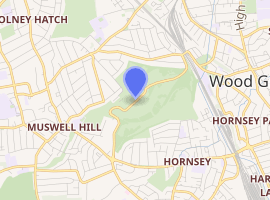
| |
| Location | Alexandra Park London, N22 |
|---|---|
| Coordinates | 51°35′38″N 0°07′48″W |
| Public transit | |
| Operator | Alexandra Park and Palace Charitable Trust |
| Capacity | 800 (Panorama Room) 1,750 (East Hall/Ice Rink) 2,000 (Palm Court) 2,500 (West Hall) 10,250 (Great Hall) 900 (seated)/1300 (seated/standing) (Theatre) |
| Construction | |
| Broke ground | September 1865 |
| Opened | 1 May 1875 |
| Renovated | 1873–75, 1980–88, 2016–17 |
| Construction cost | £417,000 (£40.2 million in 2019 pounds[1]) |
| Architect | Owen Jones, John Johnson and Alfred Meeson |
| Builder | Kelk and Lucas |
| Website | |
| Venue Website | |
Building details | |
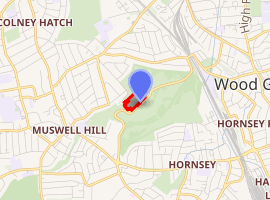
| |
| General information | |
| Inaugurated | 24 May 1873 |
At first a private venture, in 1900, the owners planned to sell it and Alexandra Park for development. A group of neighbouring local authorities managed to acquire it. An Act of Parliament created the Alexandra Palace and Park Trust. The Act required the Trustees to maintain the Palace and Park and make them available for the free use and recreation of the public forever. The present trustee is the London Borough of Haringey, whose coat of arms shows lightning bolts depicting the Palace's pioneering role in the development of television.
In 1935, the trustees leased part of the palace to the BBC for use as the production and transmission centre for their new BBC Television. In 1936, it became the home of the BBC's first regular public television service. The broadcasting system was the 405-line monochrome analogue television – the first fully electronic television system to be used in regular broadcasting. Although other facilities soon superseded it after the war, Alexandra Palace continued to be used by the BBC for many years and its radio and television mast is still in use.
The original studios 'A' and 'B' still survive in the southeast wing with their producers' galleries and are used for exhibiting original historical television equipment. The original Victorian theatre with its stage machinery also survives and as of 2019, is back in use. The theatre and stage structure is on English Heritage's Buildings at Risk register. Alexandra Palace became a listed building in 1996,[2] at the instigation of the Hornsey Historical Society.
A planned commercial development of the building into a mixed leisure complex including a hotel, replacement ice-skating rink, cinema, ten-pin bowling alley and exhibition centre, encountered opposition from public groups and was blocked by the High Court in 2007.
The Great Hall and West Hall are typically used for exhibitions, music concerts, and conferences, operated by the trading arm of the charitable trust that owns the building and park on behalf of the public. There is also a pub, ice rink, palm court, and a panoramic view of central London.
In 2013, Alexandra Park was declared a Local Nature Reserve and is also a Site of Borough Importance for Nature Conservation, Grade 1.[5][6][7]
The nearest railway stations are the Alexandra Palace with Great Northern services from Moorgate and London Underground station Wood Green on the Piccadilly line. Alexandra Palace is also served by London Buses route W3.
History
19th century
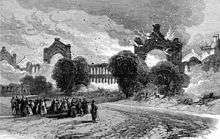
The "Palace of the People" was conceived by Owen Jones in 1859. The Great Northern Palace Company had been established by 1860, but was initially unable to raise financing for the construction of the Palace. Construction materials were acquired and recycled from the large 1862 International Exhibition building in South Kensington after it was demolished: the Government had declined to take it over. In 1863 Alexandra Park Co. Ltd. acquired the land of Tottenham Wood Farm for conversion to a park and to build the People's Palace.[8] Alexandra Park was opened to the public on 23 July 1863.
The planned building was originally named "The Palace of the People"; it and its park were renamed to commemorate the popular new Princess of Wales, Alexandra of Denmark, who had married Prince Edward on 10 March 1863. The Palace of the People, or the People's Palace, remained as alternative names. In September 1865, construction commenced but to a design by John Johnson and Alfred Meeson rather than the glass structure initially proposed by Jones.[9]
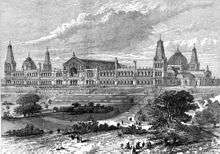
In 1871, work started on the Edgware, Highgate and London Railway to connect the site to Highgate station. Work on both the railway and the palace was completed in 1873 and, on 24 May of that year, Alexandra Palace and Park was opened. The structure covers some 7.5 acres (3.0 ha). The palace was built by Kelk and Lucas, who also built the Royal Albert Hall in South Kensington at around the same time.[10] Sims Reeves sang on the opening day before an audience of 102,000.[11] Only 16 days later, Alexandra Palace was destroyed by a fire which also killed three members of staff. Only the outer walls survived; a loan exhibition of a collection of English pottery and porcelain, comprising some 4,700 items of historic and intrinsic value, was also destroyed.[12]
With typical Victorian vigour, it was quickly rebuilt and reopened on 1 May 1875. The new Alexandra Palace contained a concert hall, art galleries, a museum, lecture hall, library, banqueting room and large theatre. The stage of the theatre incorporated machinery which enabled special effects for the pantomimes and melodramas then popular – artists could disappear, reappear and be propelled into the air. The theatre was also used for political meetings. An open-air swimming pool was constructed at the base of the hill in the surrounding park; it is long since closed and little trace remains except some reeds.
The grounds included a horse racing course with grandstand (named Alexandra Park Racecourse and nicknamed the "Frying Pan" and the "Pan Handle" because of its layout), which was London's only racecourse from 1868 until its closure in 1970, a Japanese village, a switchback ride, a boating lake and a 9-hole pitch-and-putt golf course. Alexandra Park cricket and football clubs have also played within the grounds (in the middle of the old racecourse) since 1888. A Henry Willis organ installed in 1875, vandalised in 1918 and restored and reopened in 1929, survives. In its 1929 restored form, Willis's masterpiece was declared by Marcel Dupré to be the finest concert organ in Europe.[13]
20th century
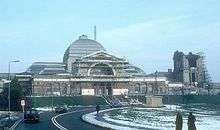
In 1900, the owners of Alexandra Palace and Park were threatening to sell them for redevelopment, but a consortium of public-spirited men in the district, headed by Mr. Henry Burt, JP a member of the Middlesex County Council and of Hornsey District Council, at once embraced the opportunity of securing the palace and the beautiful grounds for the people of London. A committee was formed by Burt and the consortium managed to raise enough money to purchase them just in time. By the Alexandra Park and Palace (Public Purposes) Act 1900, a charitable trust was created; representatives of the purchasing local authorities became the trustees with the duty to keep both building and park "available for the free use and recreation of the public forever".[14]
In 1921 a plaque was erected at the entrance of the south terrace in honour of Burt.[15] It is this duty that the present trustee, the London Borough of Haringey, is currently trying to overturn, protesters fear,[16] by selling the building to a commercial developer.[17] The palace passed into the hands of the Greater London Council in 1967, with the proviso that it should be used entirely for charitable purposes, and their trusteeship was transferred to Haringey council in 1980.
During the First World War the park was closed and the palace and grounds were first used as refugee camp for displaced Belgians,[18] and then later from 1915–19 as an internment camp[19] for German and Austrian civilians.[20][21] The camp commandant was Lt. Col. R. S. F. Walker until his death in May 1917.[22]
The theatre was greatly altered in the early 1920s, with the general manager, W. J. MacQueen-Pope, spending the war reparation money on refurbishing the auditorium. He abandoned the understage machinery that produced the effects necessary in Victorian melodrama; some of the machinery is preserved, and there is a project to restore some of it to working order. After these changes, the theatre was leased by Archie Pitt, then husband of Gracie Fields, who appeared in the theatre. Fields also drew an audience of 5,000 people to the hall for a charity event.
In 1935, the trustees leased part of the palace to the BBC for use as the production and transmission centre for their new BBC Television service. The antenna was designed by Charles Samuel Franklin of the Marconi Company. The world's first public broadcasts of (then) "high-definition" television were made from Alexandra Palace in November 1936,[23] an event which is alluded to by the rays in the modern coat of arms of the London Borough of Haringey.[24] Two competing systems, Marconi-EMI's 405-line system and John Logie Baird's 240-line system, were installed, each with its own broadcast studio and were transmitted on alternate weeks until the 405-line system was chosen in 1937.[23] After the BBC leased the eastern part of the palace the theatre was only used for props storage space.
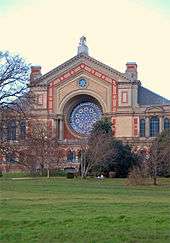
The palace continued as the BBC's main transmitting centre for London until 1956, interrupted only by the Second World War when the transmitter found an alternative use jamming German bombers' navigation systems.[25][26] In 1944, a German doodlebug exploded just outside the organ end of the Great Hall and the Rose Window was blown in, leaving the organ exposed to the elements.[27] In 1947 some of the pieces of the shattered rose window were incorporated in a new design by architect E.T. Spashett during renovation of bomb-damaged public buildings by the Ministry of Works.[28][29] During the 1940s and 50s the palace also housed a public roller-skating rink and the Alexandra Palace Roller Skating Club.
In the early 1960s, an outside broadcast was made from the top of the tower, in which the first passage of a satellite across the London sky was watched and described. It continued to be used for BBC News broadcasts until 1969, and for the Open University until 1981.[2] The antenna mast still stands and is used for local terrestrial television transmission, local commercial radio and DAB broadcasts. The main London television transmitter is now at Crystal Palace in south London.
Early in 1980, Haringey council took over the trusteeship of Alexandra Palace from the GLC, intending to refurbish the building but just six months later, during Capital Radio's Jazz Festival, a fire started under the organ and quickly spread. It destroyed half the building. Again the outer walls survived and the eastern parts, including the theatre and the BBC Television studios and aerial mast, were saved. Parts of the famous organ were destroyed, though it had been dismantled for repairs so some parts (including nearly all the pipework) were away from the building in store. Some of the damage to the palace was repaired immediately but Haringey council overspent on the restoration, creating a £30 million deficit. It was then reopened to the public in 1988 under a new management team headed by Louis Bizat. Later the council was heavily criticised for the overspend in a report by Project Management International.[30]
In 1991, the attorney-general stated that the overspending by the council as trustee was unlawful and so could not be charged to the charity. The council for some years did not accept this politically embarrassing finding and instead maintained that the charity "owed" the council £30 million, charged compound interest on what it termed a "debt" (which eventually rose to a claim of some £60 million), and to recoup it tried to offer the whole palace for sale — a policy their successors are still trying to carry out despite being rejected by the High Court in October 2007. As of June 2008, it is still unclear whether the council in either of its guises has agreed to write off its 1980s overspend.
An ice rink was installed at Alexandra Palace in 1990. Primarily intended for public skating, it has also housed ice hockey teams including the Haringey Racers, the Haringey Greyhounds, the London Racers and now the Haringey Huskies,[31] as well as a figure skating club, the Alexandra Palace Amateur Ice Skating Club.
21st century
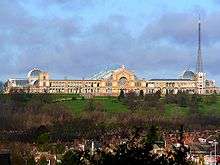
In June 2004, the first performances for about 70 years took place in the theatre, first in its foyer then in July in the theatre itself. Although conditions were far from ideal, the audience was able to see the potential of this very large space – originally seating 3,000, it could not be licensed for more than a couple of hundred. It was intended that the theatre will one day reopen, but much costly restoration would be required first. It will never again reach a seating capacity of 3,000 (not least because one balcony was removed in the early part of the 20th century as a fire precaution, when films started to be shown there). A major season of the theatre company Complicite was planned for 2005 but the project, which would have included some repair and access work, was cancelled due to higher-than-anticipated costs.[32]
Plans by the current trustees, Haringey Council, to replace all the charitable uses by commercial ones by a commercial lease of the entire building, including a casino, encountered considerable public and legal opposition, and on 5 October 2007, in the High Court, Mr. Justice Sullivan granted an application by Jacob O'Callaghan, a London resident, to quash the Charity Commission's order authorising a 125-year lease of the entire building to Firoka Ltd.[33]
A masterplan for the future of the site was drawn up in 2012, comprising six 'big ideas' to restore and redevelop the palace.[34] The first of these to be implemented aims to transform the derelict eastern end of the palace, making accessible the Victorian theatre and historic BBC Studios. In 2013 the Heritage Lottery Fund awarded a Round 1 pass to develop the proposals, creating a new entrance in the restored East Court, re-establishing the theatre as a flexible performance space and re-opening the BBC Studios as a visitor attraction. There was controversy regarding plans to demolish the brick infills in the colonnade on the south-east face of the building, which the BBC constructed after 1936 to form their television studios within.[35] Following a public consultation and advice from English Heritage, Planning and Listed Building Consent was given for the proposals and in March 2015 HLF awarded Round 2 major grant funding securing a positive future for the historic areas.[36]
In 2018 it was announced that the Theatre would open for a BBC Proms performance on 1 September[37] before officially reopening to the public on 1 December 2018 following the completion of the East Wing Restoration Project by the contractor Willmott Dixon.[38] The opening programme included performances from Dylan Moran, Horrible Histories, Gilbert & George, Gareth Malone and an evening of jazz presented by Ronnie Scott's.[39]
Notable events
Alexandra Palace has hosted a number of significant events over the course of its history. Recurring events held there include the Great British Beer Festival (1977–1980),[40] the Brit Awards (1993–1995), the PDC World Darts Championship (2008–present) and the Masters snooker tournament (2012–present).
In November every year, a large fireworks display is scheduled there as part of London's Bonfire Night celebrations.
1960s
The Observer's Wildlife Exhibition held here in 1963 was an important early event in highlighting awareness of worldwide endangered species, and it gained a large attendance (46,000).[41]
In April 1967, a benefit event took place there. The 14 Hour Technicolor Dream, organised by the International Times, demonstrated the importance of the quickly developing Underground scene. Although venues such as the UFO Club were hosting counter-cultural bands, this was certainly the largest indoor event at the time. Performers included headlining act Pink Floyd as well as the Pretty Things, Savoy Brown, the Crazy World of Arthur Brown, Soft Machine, The Purple Gang, The Move and Sam Gopal's Dream (featuring Sam Gopal, Mick Hutchinson and Pete Sears). John Lennon attended, and Yoko Ono (who was soon to become Lennon's new romantic partner) presented her performance work "Cut Piece".[42]
1970s
In 1970, Italian director Lucio Fulci filmed an important segment of his giallo film A Lizard in a Woman's Skin here. Alexandra Palace posed as a disused church.[43] The rock band Led Zeppelin played at Alexandra Palace in December 1972.
In 1973, the Divine Light Mission held a "Festival of Love" there.[44] Also in 1973, British rock band Wishbone Ash played a Christmas concert at the palace, billed as "Christmas at the Palace".
The American band Grateful Dead played a series of three shows there between 9 and 11 September 1974 and a recording of portions of all three shows was released as part of the Dick's Picks series in March 1997.
The Campaign for Real Ale held the Great British Beer Festival there from 1977 to 1980[40] (the 1980 edition taking place in tents outside the fire-damaged Alexandra Palace[45]).
From July 27 to August 5 The London Music Festival '73 was held here. It claimed to be the biggest indoor rock festival ever staged.
1980s
After the fire, the burnt-out shell of the great hall of Alexandra Palace was used as Victory Square in Michael Radford's 1984 film adaptation of George Orwell's novel Nineteen Eighty-Four.
The Sinclair C5 battery electric vehicle was launched at the palace in January 1985, one week after the closure of the 405-line television system that was inaugurated there 49 years earlier.
In November 1989 the Stone Roses played their first major gig in the South of England at Alexandra Palace, notable particularly as the band sold the venue out before being featured significantly in the music press or making any national television appearances.
1990s
Hugh Cornwell played his last gig with the Stranglers at Alexandra Palace in August 1990.
Blur performed a major concert at the venue in October 1994 to promote their album Parklife. The recording of the concert was released on video in February 1995 with the title Showtime and used as the basis for the video for the band's song "End of a Century".
From 1993 to 1995, the Brit Awards were hosted at Alexandra Palace. In November 1996 it was the venue for the annual MTV Europe Music Awards.
2000s
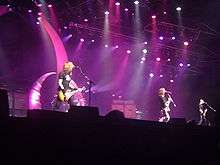
The fourth Mind Sports Olympiad was held at Alexandra Palace in August 2000, with more than 4,000 competitors from around the world taking part in mind sports.[46]
On November 7, Alexandra Palace has hosted Miss World 2002 where Azra Akın of Turkey was crowned as the new Miss World.
In June 2007, a Hackday event was hosted at Alexandra Palace by the BBC and Yahoo! During the event, the building was struck by lightning, causing the fire vents to open (and then get stuck open), and it rained inside the building.[47]
Since December 2007, Alexandra Palace has hosted the PDC World Darts Championship,[48] following 14 years from December 1993 to January 2007 of the tournament being held at the Circus Tavern in Purfleet, Essex. The palace was previously home to the News of the World Darts Championship between 1963 and 1977.
April 2008 saw the re-launch of the regular antiques fairs,[49] now held four times a year, organised by International Antiques & Collectors Fairs (IACF).
2010s
The band Portishead hosted one of two All Tomorrow's Parties festivals titled I'll Be Your Mirror in July 2011 at Alexandra Palace.[50] The 50th anniversary programme of Songs of Praise was recorded there in September 2011 and broadcast the following month.[51]
Since 2012 and until 2019, it is the venue for the Masters snooker tournament, held every January.[52]
During the 2012 Summer Olympics it served as the official hospitality venue for the Dutch Olympic team.[53]
In November 2012, it was the venue for the annual Warped Tour, a music and extreme sports festival.
Alexandra Palace continues to be a prolific and high-profile music venue attracting internationally renowned artists. Suede appeared in March 2013, playing one of the first dates in support of Bloodsports, their first new album in more than a decade. In September 2013, Björk performed one of the final concerts of her Biophilia Tour. The show was the last concert to be held "in the round", a format which characterised the tour, and the first to be performed in this way at Alexandra Palace.[54][55] The eclectic programming has included in 2015, Florence and the Machine playing 4 dates of their How Big, How Blue, How Beautiful Tour in the palace as well as in 2016 alone, heavy metal band Slipknot, Drum & Bass DJ Andy C and the Last Shadow Puppets; with sell out shows by Twenty One Pilots[56] and Panic at the Disco.[57]
The bootcamp stage for series 13 of The X Factor was filmed at the Alexandra Palace from 6 to 8 July 2016.[58]
2020s
On 23 July 2020 during the COVID-19 pandemic Nick Cave performed Id... prayer, a solo piano show for global streaming.
Notes and references
- UK Retail Price Index inflation figures are based on data from Clark, Gregory (2017). "The Annual RPI and Average Earnings for Britain, 1209 to Present (New Series)". MeasuringWorth. Retrieved 2 February 2020.
- Historic England. "Details from listed building database (1268256)". National Heritage List for England. Retrieved 3 November 2011.
- "Alexandra Park Conservation & Heritage Management Plan" (PDF). Alexandra Park and Palace Charitable Trust. January 2011. Archived from the original (PDF) on 13 June 2018. Retrieved 13 June 2018.
- O'Connor, John J. (17 November 1986). "TV Reviews; Film Celebrates BBC's 50th Birthday". New York Times. Retrieved 8 July 2011.
- "Alexandra Park". Local Nature Reserves. Natural England. 20 March 2014. Retrieved 9 April 2014.
- "Alexandra Park". Greenspace Information for Greater London. 2013. Archived from the original on 13 April 2014. Retrieved 9 April 2014.
- "iGiGL data portal (map)". Greenspace Information for Greater London. Archived from the original on 14 January 2014. Retrieved 9 April 2014.
- "A Brief History of Alexandra Palace and Park". Hornsey Historical Society. January 2018. Retrieved 13 June 2018.
- Banerjee, Jacqueline. "Alexandra Palace". Archived from the original on 23 July 2008. Retrieved 31 May 2013.
- "Charles Thomas Lucas at Oxford Dictionary of National Biography". Oxford Dictionary of National Biography. 2004. doi:10.1093/ref:odnb/49439. Retrieved 8 July 2011. Cite journal requires
|journal=(help) - Pearce, Charles E. (1924). Sims Reeves: Fifty Years of Music in England. London: Stanley Paul. p. 307.
- Arthur Hayden, Spode and His Successors (Cassell, London 1925), pp. 12, 90.
- Felix Aprahamian, The Alexandra Palace Organ, Sleevenote to HMV HQM 1199 (Hayes 1970).
- "Our History". alexandrapalace.com. Retrieved 7 June 2018.
- "Henry Burt". London Remembers. Retrieved 1 December 2018.
- "saveallypally.com". saveallypally.com. 1 June 2007. Retrieved 8 July 2011.
- Ham & High
- Palace, Alexandra (15 August 2014). "Alexandra Palace launches exhibition commemorating WW1 heritage | Alexandra Palace". www.alexandrapalace.com. Retrieved 18 February 2016.
- "Alexandra Palace's war time efforts to be showcased in new app and video | Middlesex University London". www.mdx.ac.uk. Retrieved 18 February 2016.
- "WWI Internees at Alexandra Palace, London, England". Family History Circle. 7 November 2008. Retrieved 26 February 2011.
- "Alexandra Palace as a concentration camp". British association for Local History. 2005. Archived from the original on 2 October 2011. Retrieved 26 February 2011.
- "No. 30278". The London Gazette. 11 September 1917. p. 9396.
- Burns, R.W. (1998). Television: An International History of the Formative Years. London: The Institution of Electrical Engineers. p. ix. ISBN 978-0-85296-914-4.
- "Coat of arms". London Borough of Haringey. Archived from the original on 6 May 2006. Retrieved 21 December 2013.
- "Timeline". alexandrapalace.com. Retrieved 7 June 2018.
- "The History of the BBC: Alexandra Palace's Secret War". www.televisionheaven.co.uk. 2004. Archived from the original on 12 June 2018. Retrieved 7 June 2018.
- Aprahamian 1970, loc. cit.
- National Ar4chives: Records of the successive Works departments, and the Ancient Monuments Boards and Inspectorate, Ministry of Works, 1943–1962
- Archives of E.T. Spashett ARIBA
- Project Management International plc, Alexandra Palace: Report for the London Borough of Haringey (1990)
- Harris, Martin C. (2005). Homes of British Ice Hockey. History Press. p. 116. ISBN 978-0752425818.
-
Gillespie, Ruth (8 February 2005). "Complicite scraps plans for Alexandra Palace rebirth". The Stage News. The Stage. Retrieved 25 June 2008.
The company had announced plans for a £500,000 refurbishment of the 19th century building last year, more than 65 years after the venue went dark and planned to occupy the space for 12-weeks in the spring. However, Complicite has been forced to abandon its proposals after the cost of essential safety work on the 2,500-seat auditorium shot up from £160,000 to £310,000.
- "Court rejects £55m Palace plans". BBC News. bbc.co.uk. 5 October 2007. Retrieved 25 June 2008.
Firoz Kassam, the former chairman of Oxford United Football Club, wants to refurbish the building's exhibition halls, add a 150-bedroom hotel, casino, bars and restaurants and provide public leisure facilities on the site. But on Friday the judge quashed a Charity Commission order which permitted palace trustees to enter into a 125-year lease with Mr Kassam's development company, Firoka Group. Mr Justice Sullivan said lease details were not given in time for public consultation, so the whole consultation process must be reopened.
- Palace, Alexandra. "East Wing Restoration – Alexandra Palace".
- "Archived copy". Archived from the original on 2 April 2015. Retrieved 25 March 2015.CS1 maint: archived copy as title (link)
- "Alexandra Palace secures £18.8m funding for theatre revamp". BBC News. 25 March 2015.
- "Sierra Boggess to star in West Side Story at BBC Proms". The Stage. 19 April 2018. Retrieved 2 May 2018.
- Brown, Mark (26 April 2018). "Alexandra Palace's 'hidden' theatre to reopen after £18.8m restoration". the Guardian. Retrieved 2 May 2018.
- "Ally Pally's hidden theatre launches first season in December". Evening Standard. Retrieved 2 May 2018.
- "History of the Great British Beer Festival". www.gbbf.org.uk. Archived from the original on 12 June 2018. Retrieved 7 June 2018.
- William M. Adams, Against Extinction:The Story of Conservation (Earthscan 2004), p. 61. Example of display,
- "Nothing Found For Npf Mag 311 Syd Barrett And The Beatles 1966 1969 By John J Olivar 404". Archived from the original on 28 June 2011.
- "A Lizard in a Woman's Skin". 20 March 1973 – via IMDb.
- Price, Maeve (1979): "The Divine Light Mission as a social organisation". Sociological Review, 27, Page 279–96.
- "The History of CAMRA". 2014. Retrieved 7 June 2014.
- Fierce rivalry in 'Olympics' for brainboxes, CNN, Paul Sussman, 23 August 2000, Archived 26 September 2012 at the Wayback Machine retrieved 18 July 2012
- "When hacks attack". The Guardian. London. 25 June 2007. Retrieved 24 September 2014.
- "World Darts moves to London". BBC News. 2 April 2007. Retrieved 8 July 2011.
- Nelson Fairs Ltd. "antiques fair". Alexandrapalaceantiquesfair.co.uk. Archived from the original on 3 September 2011. Retrieved 8 July 2011.
- "I'll Be Your Mirror London curated by Portishead & ATP – All Tomorrow's Parties". Atpfestival.com. Archived from the original on 5 June 2011. Retrieved 4 June 2011.
- "Songs of Praise 50th Birthday Celebration".
- "The Masters Snooker Relocates to Alexandra Palace for 2012". Alexandra Palace. 26 April 2011. Retrieved 5 August 2011.
- "to host Olympic Holland Heineken House". Alexandra Palace. December 2010. Retrieved 6 August 2011.
- Murray, Robin. "Bjork Announces London Show". Clash. Retrieved 11 June 2013.
- "Björk announces oneBjörk announces one-off London gig on September 3 – ticket details". NME. 11 June 2013. Retrieved 11 June 2013.
- "Twenty One Pilots Shows". bandsintown.com.
- "Panic! at the Disco Shows". bandsintown.com.
- "The X Factor 2016: Country house Boot Camp axed and new location revealed". Andrew Bullock. 7 July 2016. Retrieved 26 September 2016.
External links
| Wikimedia Commons has media related to Alexandra Palace. |
- Alexandra Palace (Victorian London)
- Save Ally Pally: campaign to maintain the charitable status of the palace and preserve its TV studios, organ and Victorian theatre for the public
- Heritage at Risk Register: Alexandra
- Detailed history of early BBC TV broadcasts, with archive photos 2003-09-14
- Alexandra Palace Television Society
- Unofficial History of BBC Television at Alexandra Palace
- Pictures and Information About Alexandra Palace History
- Hornsey Historical Society
- Friends of Alexandra Park – website promoting and protecting Alexandra Park in North London
- Friends of Alexandra Palace Theatre
- Restoration – Alexandra Palace – The East Wing Keith Armstrong 2018 The author’s personal photographic record documenting the 2 year project.
- History of the Peoples Palace – West Corridor Murals designed and painted by Haringey Mural Workshop artists: Gary Drostle, Ruth Priestly, Hilary Leobner, Joann White, John Beaumont
